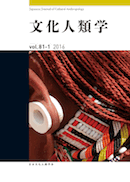Volume 84, Issue 4
Displaying 1-34 of 34 articles from this issue
- |<
- <
- 1
- >
- >|
front matter
-
2020 Volume 84 Issue 4 Pages f1-
Published: 2020
Released on J-STAGE: May 28, 2020
Download PDF (541K) -
2020 Volume 84 Issue 4 Pages f2-
Published: 2020
Released on J-STAGE: May 28, 2020
Download PDF (1656K) -
2020 Volume 84 Issue 4 Pages i-iii
Published: 2020
Released on J-STAGE: May 28, 2020
Download PDF (916K) -
2020 Volume 84 Issue 4 Pages iv-v
Published: 2020
Released on J-STAGE: May 28, 2020
Download PDF (925K) -
2020 Volume 84 Issue 4 Pages vi-vii
Published: 2020
Released on J-STAGE: May 28, 2020
Download PDF (1050K) -
2020 Volume 84 Issue 4 Pages viii-xi
Published: 2020
Released on J-STAGE: May 28, 2020
Download PDF (1284K) -
2020 Volume 84 Issue 4 Pages xii-xx
Published: 2020
Released on J-STAGE: May 28, 2020
Download PDF (1616K) -
2020 Volume 84 Issue 4 Pages 383-384
Published: 2020
Released on J-STAGE: May 28, 2020
Download PDF (129K) -
2020 Volume 84 Issue 4 Pages 385-
Published: 2020
Released on J-STAGE: May 28, 2020
Download PDF (1045K) -
2020 Volume 84 Issue 4 Pages 386-
Published: 2020
Released on J-STAGE: May 28, 2020
Download PDF (1060K)
JASCA Award Lecture 2019
-
2020 Volume 84 Issue 4 Pages 387-412
Published: 2020
Released on J-STAGE: May 28, 2020
Download PDF (1522K)
Article
-
2020 Volume 84 Issue 4 Pages 413-430
Published: 2020
Released on J-STAGE: May 28, 2020
Download PDF (1571K)
Special Theme: Dynamics in the Indexical Process of Signification: Perspectives from Linguistic Anthropology
-
2020 Volume 84 Issue 4 Pages 431-442
Published: 2020
Released on J-STAGE: May 28, 2020
Download PDF (1542K) -
2020 Volume 84 Issue 4 Pages 443-462
Published: 2020
Released on J-STAGE: May 28, 2020
Download PDF (1420K) -
2020 Volume 84 Issue 4 Pages 463-481
Published: 2020
Released on J-STAGE: May 28, 2020
Download PDF (3115K) -
2020 Volume 84 Issue 4 Pages 482-502
Published: 2020
Released on J-STAGE: May 28, 2020
Download PDF (2586K) -
2020 Volume 84 Issue 4 Pages 503-521
Published: 2020
Released on J-STAGE: May 28, 2020
Download PDF (2414K) -
2020 Volume 84 Issue 4 Pages 522-531
Published: 2020
Released on J-STAGE: May 28, 2020
Download PDF (1832K)
Correspondence
-
2020 Volume 84 Issue 4 Pages 532-533
Published: 2020
Released on J-STAGE: May 28, 2020
Download PDF (1154K)
Book Reviews
-
2020 Volume 84 Issue 4 Pages 534-535
Published: 2020
Released on J-STAGE: May 28, 2020
Download PDF (1270K) -
2020 Volume 84 Issue 4 Pages 535-537
Published: 2020
Released on J-STAGE: May 28, 2020
Download PDF (1345K) -
2020 Volume 84 Issue 4 Pages 537-540
Published: 2020
Released on J-STAGE: May 28, 2020
Download PDF (1426K) -
2020 Volume 84 Issue 4 Pages 540-543
Published: 2020
Released on J-STAGE: May 28, 2020
Download PDF (1432K) -
2020 Volume 84 Issue 4 Pages 543-546
Published: 2020
Released on J-STAGE: May 28, 2020
Download PDF (1438K) -
2020 Volume 84 Issue 4 Pages 546-549
Published: 2020
Released on J-STAGE: May 28, 2020
Download PDF (1445K) -
2020 Volume 84 Issue 4 Pages 549-551
Published: 2020
Released on J-STAGE: May 28, 2020
Download PDF (1363K)
Information
-
2020 Volume 84 Issue 4 Pages 552-555
Published: 2020
Released on J-STAGE: May 28, 2020
Download PDF (1236K) -
2020 Volume 84 Issue 4 Pages 556-557
Published: 2020
Released on J-STAGE: May 28, 2020
Download PDF (1002K) -
2020 Volume 84 Issue 4 Pages 558-559
Published: 2020
Released on J-STAGE: May 28, 2020
Download PDF (1070K) -
2020 Volume 84 Issue 4 Pages 560-
Published: 2020
Released on J-STAGE: May 28, 2020
Download PDF (1010K)
back matter
-
2020 Volume 84 Issue 4 Pages bi-biii
Published: 2020
Released on J-STAGE: May 28, 2020
Download PDF (1033K) -
2020 Volume 84 Issue 4 Pages biv-bv
Published: 2020
Released on J-STAGE: May 28, 2020
Download PDF (1096K) -
2020 Volume 84 Issue 4 Pages b1-
Published: 2020
Released on J-STAGE: May 28, 2020
Download PDF (1656K) -
2020 Volume 84 Issue 4 Pages b2-
Published: 2020
Released on J-STAGE: May 28, 2020
Download PDF (373K)
- |<
- <
- 1
- >
- >|
